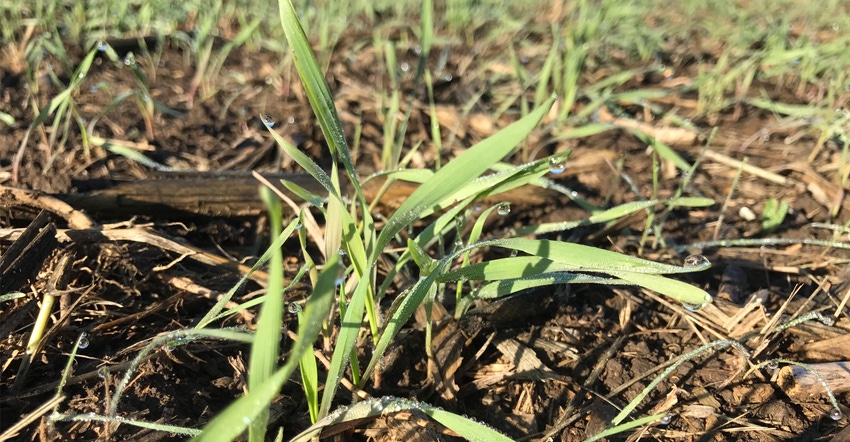November 22, 2021

For the last 15 years, Eric Schmechel has been working in the watershed field in Dubuque County, Iowa, and has met challenges with integrating conservation into his work.
"I've struggled as a person that's trying to get more conservation on the ground," he says.
But he's found a way to move the needle using an innovative program with Truterra, the sustainability arm of the Land O'Lakes cooperative.
Schmechel says he's working to lose the gap where farmers are listening to sales agronomists and the information given versus conservationists, and the "gaps between those messages." But there's a need to reduce nitrogen and phosphorus coming from farms into the watershed — which heads straight for the Mississippi River — while helping farmers maintain profitability.
In a conversation with Jason Weller, president, Truterra LLC, Schmechel says work began to connect the dots between the need for managing water flows into the watershed, and on farm practices upstream.
Schmechel says that using the Truterra sustainability tool is "a way of trying to showcase the technology of precision agriculture, of improving conservation and profitability at the same time, but also trying to build relationships with other agronomists in our county and with private industry."
Paying for conservation
Dubuque County, the Dubuque County Soil and Water Conservation District, Truterra and local Truterra ag retailer Innovative Ag Service launched the Land Stewardship Initiative in 2021. In the first year, 26 farmers participated across nearly 2,800 acres in the county to adopt more sustainable farming practices. A focus area was creating a healthier watershed, and with quantifiable and verifiable progress achieved between 2020 and 2021, it's anticipated participating farmers will be compensated $92,000, or about $33 per acre from the program.
When it comes to promoting more conservation practices — in this case driven by a need to improve water quality downstream — there's a challenge: What's in it for the farmer? "If the profitability piece isn't there, it's very tough to sell any piece of conservation," Schmechel says. "Whether you're talking structural projects or tillage changes or just practice changes in general, profitability has to be part of the conversation."
The Truterra sustainability tool allows for flexibility in the practices farmers can adopt, yet provides accurate measurement of the benefits and value of each approach. Schmechel notes that some government or private programs can be rigid in their construction, but the approach taken for this project offers farmers choices in how they engage.
"And Truterra offers a great way of just tracking the acres and the reduction, and we're trying to be more transparent to the public," he adds.
One approach that sets this program apart from some other practices like cover crops and tillage changes farmers may have heard about is measuring nutrient management on those participating farms. Spencer Herbert with Truterra explains that a benefit of the sustainability tool is that "we can work with all of the tools and practices the growers have available to them to make improvements." So your traditional practices that may offer government assistance, or government programs for tillage or cover crops, but farmers can also make significant environmental improvement just based on their agronomic practices," he adds.
Measuring the impact of nitrogen stabilizers, variable-rate nutrient application and other similar practices has an environment benefit, and is important agronomically. "So, we tie those together and look at it as a holistic profitability, environmental, and agronomic solution," Herbert says.
Measuring impact
In 2021, participating farmers took on advanced nutrient management systems on 1,591 new acres, adopted cover crops on 1,175 new acres and adopted no-till on 183 new acres. The result:
On average, participating acres were net carbon-negative, sequestering nearly twice the quantity of greenhouse gases in 2021 as they emitted in 2020. The program measured a 196% reduction in net greenhouse gas emissions because of those stewardship practices.
If you do the math, technically you can cut something more than 100%, but Herbert explains that the sequestration of carbon and reduced emissions resulted in a net negative for these acres. That adds up to a 196% reduction.
Local water quality also improved based on two metrics. In 2021, participating farmers reduced the amount of nitrogen lost from fields to local waterways by 21.9 pounds per acre; for phosphorus, there was a 2.67 pounds per acre reduction. Participating farmers also reduced sheet and rill erosion by nearly one-sixth between 2020 and 2021, keeping soil on the field.
Schmechel says the nutrient reduction numbers are exciting, and he's working with different measurement models all the time to track nutrient flows in the watershed. But these numbers from this Land Stewardship Initiative are exciting, and the work continues. "This gives us the next set of goals as we move into 2022 �— to see if we can continue to beat those every year," he says.
About the Author(s)
You May Also Like






